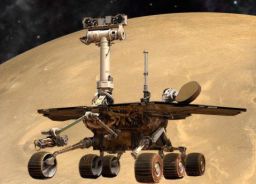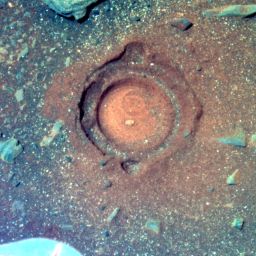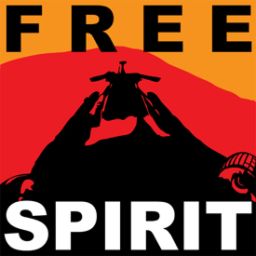A.J.S. Rayl • Jul 31, 2009
Mars Exploration Rovers Update: Spirit Works as Team Tests Exit Moves, Opportunity Roves to Block Island
The Mars Exploration Rovers maintained a busy schedule in July: Spirit worked day and night doing whatever it could to make use of its abundant energy; Opportunity effectively treated its “hot” right front wheel and got back to making some consecutive long drives toward the still distant Endeavour Crater.
But most of the spotlight action on the mission this month took place at the indoor Mars yard at the Jet Propulsion Laboratory (JPL). That’s where Spirit’s engineers and scientists sunk a ground test rover up to its ‘hubcaps’ in a sandbox filled with a yellow-tan powdery substitute for Martian dirt and began testing maneuvers to evaluate the best exit strategy for their mobility impaired robot up on Mars, a process the team anticipated last month would take several weeks.
A steady stream of tour groups – from students to tourists – peered in on the action from the roverwalk overlooking the In-Situ Instrument Laboratory (ISIL) as the Mars yard is officially called, while tens of thousands hit the Free Spirit website to follow along as the MER crew members put the ground rover through the paces. In some tests, the rover spun its wheels forward, in others it moved them backward, and sometimes it moved sideways or ‘crabbed,’ and in every case, every centimeter of movement was measured.
“It's been wonderful for the team just to see how excited the public is about this,” said engineer Sharon Laubach, the integrated sequencing team chief for the mission, based at JPL, the birthplace and mission control of the twin robot field geologists. “They understand our travails and tribulations and it feels like they're right there with us.”
Spirit roved into trouble on Mars back in April as it was making its way around the western side of Home Plate, the circular volcanic formation it had been studying the previous couple of years. It was en route to the next big attractions to the south, a house-sized pit called Goddard and an unusual mound named von Braun. But as it tried to drive up a slight slope or rise to get on more firm terrain, its left wheels apparently broke through an outer crust and slipped into a patch of Martian mystery sand.
By the first week in May, Spirit was effectively “mobility impaired,” as Deputy Principal Investigator Ray Arvidson, of Washington University St. Louis, insists. And ever since then, it’s been parked in that patch, just west of Home Plate, its left wheels dug in the sandpit dubbed Ulysses within the area called Troy.
“It’s the worst embedding event seen by either of the rovers,” said JPL’s John Callas, MER project manager.
But, just when it seemed Spirit was at a real standstill, the magic inherent in this mission appeared once again. The rover had roved into some more accidental pay dirt.
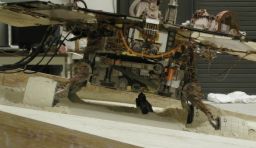 Free Spirit test bed
Free Spirit test bedWith a slope of about 10 degrees and a pointy rock under the test rover's belly, this sandbox setup at NASA's JPL was prepared for engineers to use the test rover to assess possible moves for getting Spirit out of a patch of loose Martian soil. The rock beneath the test rover was put in place on July 1, 2009, to resemble a rock underneath Spirit on Mars. Credit: NASA/JPL-Caltech
“Holy smokes! This is such a bonanza of a place,” Arvidson exclaimed during an interview yesterday. “If I wanted to be mobility impaired, this would be the place, of all places for Spirit anywhere in the mission. Why? Because here we can establish the layering, the stratigraphy of the sulfate-rich deposits that we're measuring to put the whole story of this region together.”
Thus, Spirit has had a lot more to do than simply bide its time. And that bonanza has certainly taken the worst of the pressure off the crew in the test bed at home.
About a dozen people report to the ISIL every day to work on how to get Spirit out of the intriguing Martian mess and back onto firmer turf, according to Callas. “But everyone is helping out, getting hot, sweaty, and dirty,” he said. “The project is pretty short-handed. While we have enough people to staff the two rovers and there's not much slack left over,” elaborated Bruce Banerdt, MER project scientist, who spent several shifts during the last couple of weeks in the “dustbin,” as the sandbox is now called. “We're down to bare bones.”
But there’s nothing bare bones about the MER team’s enthusiasm. The Free Spirit logo, designed by John Howard, a member of JPL's media relations team, is everywhere, on posters on the walls, the team’s jumpsuits, T-shirts, hats, and mugs – and it seems readily apparent that the MER team has embraced the challenge with all the spirit of their Spirit.
During the first three weeks of July, they conducted a series of about 10 different 'atomic' maneuvers with the ground rover. “These are maneuvers we did for 20-meter segments just to see what kind of progress we could get and to winnow that number down to the most likely candidates for getting us extracted,” Laubach explained.
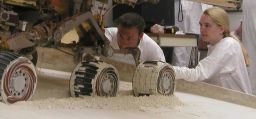 Testing exit strategies
Testing exit strategiesMER engineer Mike Seibert and Sharon Laubach check the exact position of a test rover in preparation for a test of a possible maneuver for Spirit to use on Mars. The test setup at JPL simulates the situation where Spirit is embedded in a patch of soft soil dubbed Ulysses in an area known as Troy, in Mars' Gusev Crater. The July 7, 2009 preparation, shown here, preceded an assessment of straight-backward driving the next day, one of several possible maneuvers to be assessed in the test sandbox before further driving commands will be sent to Spirit.
Credit: NASA/JPL-Caltech
All told, the tests this month were successful. “The good news in the test bed is that every test has made progress, forward, backward, up hill, down hill,” Laubach announced. “In every test, the vehicle has made some movement.”
Following a review of their work on July 23, the Free Spirit crew had three candidate maneuvers. Better still, the scientists noted that the ground test rover actually seemed to be in more dire straits than Spirit. “It seems that what we have in the sandbox is more challenging to drive in than what's on Mars, because we think the material Spirit is in has more sand-sized particles in it, which are visible in the microscopic imager (MI) pictures,” said Banerdt. “That usually gives you a little bit more traction. We don't have any sand-sized particles in the mix of diatomaceous earth and fire clay material we have in the sandbox.”
The other thing the scientists have found is that the ground on the uphill side, the right side of the rover, is “a little stronger” than the downhill side and probably offers more traction, Banerdt continued. “We do think that we're mostly stuck on one side of the rover.”
The crew took that into account as it moved into the next round of extrication maneuver testing this week. “For this second phase, we're trying to simulate the difference between the uphill side and downhill side by preparing the two sides of the test rig differently,” said Banerdt. “We've been packing the uphill side, doing extra tamping [compressing of the sand] on the right side of the vehicle, so we better mimic what's on Mars.”
“I think the message is that once we begin the extrication process on Mars we can expect steady slow progress,” offered a confidant Arvidson. Provided the second phase of testing goes according to schedule and expectation, that process will be happening sooner rather than later.
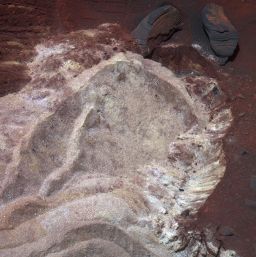 Ulysses in Troy
Ulysses in TroySpirit accidentally slipped through a patch of ground in an area the team calls Troy back in April. Inside the area, the rover churned up a mixture of light-toned soils unlike anything either MER has seen. The variations in this mixture, now called Ulysses, are revealed in pastel hues visible in this panoramic camera (Pancam) image, which has been stretched to emphasize the differences. The rover used its Pancam on its Sol 1892 (Apr. 29, 2009) to take the three images combined into this composite image. The three images were taken through filters centered at wavelengths of 750 nanometers, 530 nanometers and 430 nanometers. Spirit became embedded here about a week later. The two rocks near the upper right corner of this view are each about 10 centimeters (4 inches) long and 2 to 3 centimeters (1 inch) wide.Credit: NASA / JPL-Caltech / Cornell
As the schedule is set now, the Free Spirit team will go before another review panel on August 5. “Assuming the review goes well and the panel is happy with the testing we've completed so far, then the current plan is that on Friday, August 7, we will begin commanding extraction on Mars,” Laubach announced. “Keep your fingers and toes crossed.”
Despite Spirit’s trials and tribulations, team morale remains high. “On the science team, spirits are very high, because they're doing a lot of science work right now, studying the soil to support the extraction activities, but at the same time investigating what is actually a treasure trove of stuff,” said Banerdt.
Beyond taking measurements and analyzing every type of soil it can detect around its wheels with the instruments on its robotic arm or instrument deployment device (IDD), Spirit has conducted a thorough science campaign of its surroundings, immediate, near, and far. It has taken thousands of images for a new 360-degree panorama, called Calypso, as well as dozens of measurements with its panoramic camera (Pancam) and its miniature thermal emission spectrometer (Mini-TES). With abundant daily energy the rover is now routinely conducting nighttime activities, shooting Venus and the Martian moons, to increase the depth of discharge in the batteries, necessary for battery health and maintenance.
“Plus, it's hard to be depressed when Spirit is getting so much energy,” Banerdt added. In fact, Spirit really must stay ever active now because of its rich bounty of power. “We have such good power that if the batteries stay fully charged for a significant period of time, then they lose their capacity for recharging,” Laubach explained. “So we've actually been running excess heating, doing the nighttime activities, and staying up late all to try to drain the batteries to keep them healthy.”
Meanwhile, over at Meridiani Planum, Opportunity kept on truckin’ toward Endeavour Crater. The rover seems to have effectively “treated” its “hot” right front wheel by warming it up regularly while resting it. For the first time in months, the rover was able to make consecutive long distance drives with the current to the right front wheel only rising slightly.
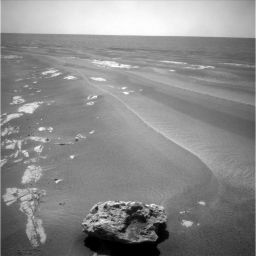 Block Island
Block IslandOpportunity is currently checking out this large odd-shaped cobble, about 0.6 meters (2 feet) long. It may be a meteorite. The team spotted the rock they call Block Island on July 18, 2009, located in the opposite direction from which the rover was driving. It was interesting enough that the team had the rover turn around and backtrack some 250 meters (820 feet) to check it out up close. Scientists will be looking at the rock with the alpha particle X-ray spectrometer to determine its composition and to confirm if indeed it is a meteorite.
Credit: NASA / JPL-Caltech
This week, Opportunity pulled up to an unusual looking cobble, where it will hunker down for a few sols of science. “We're approaching a rock called Block Island that may or may not be a meteorite,” said Arvidson. “The idea is to get up and close and personal with it and do the measurements to see if it is metallic.”
Both Spirit and Opportunity have seen meteorites before, but Block Island looks different. “It's not just the fact that it's a meteorite that we're stopping,” Arvidson said. “We're getting up close to it to see if it’s corroded at all. If, for example, it is camasite – an iron-nickel alloy in meteorites – or if it's corroded, it would be interesting in that it might be telling us something about current weathering characteristics of Mars.”
The big news – and the best news – from Meridiani Planum this month though is that the team has found a way to mitigate the elevated currents drawn by the rover’s right front wheel motor. “The currents have been more normal than we’ve seen in a long time. While we still see some elevation in that right front wheel current, especially on turns, overall the driving was pretty stable this month.” Laubach reported. That comes as real relief, especially considering that Opportunity still have some 15 kilometers to go to get to Endeavour.
Spirit and Opportunity passed their physicals in July with flying colors and each rover is producing a healthy amount of power. While Opportunity is producing an average of around 450 watt-hours of power, half of Spirit’s average of 925 watt-hours this month, it’s still plenty enough for cruising the plains of Meridiani.
Spirit’s power levels actually went as high as 949 watt-hours in the middle of the month – about what the rover boasted shortly after landing – and now hovering around 915 watt-hours. Mars is definitely smiling down on this rover these days. The atmospheric opacity or tau at Gusev is low, around is 0.35, with the dust factor on the rover’s solar array at about 0.84, indicating that 84% of the sunlight hitting the array is penetrating the ultra-thin layer of dust and being utilized to produce energy. Opportunity, on the other hand, is seeing dustier skies and is only utilizing a little more than half the amount of sunlight hitting its solar panels.
There could be trouble ahead though. Recent observations from the Mars Climate Sounder instrument onboard the Mars Reconnaissance Orbiter (MRO) reveal that a large regional storm is developing. It’s not near Spirit or Opportunity right now, but on Mars that can change quickly. The planet is still in its dust storm season, so it’s possible, maybe probable that the storm will continue to grow. Additional report in coming sols will tell whether Spirit and/or Opportunity need to batten down the hatches.
Spirit From Gusev Crater
On July 1, the Free Spirit team placed one final rock underneath their ground rover in the sandbox in the In-Situ Instrument Laboratory (ISIL) in preparation for extrication maneuver testing. “We can’t call AAA, ,” said Callas, “so we have to bring Mars down to Earth.”
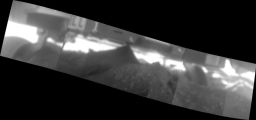 Self portrait
Self portraitSpirit took this panorama of images on its Sol 1925 (June 2, 2009) to help its ground team assess its current state and plan its extraction from the soft soil known as Ulysses in the region called Troy. The rover took the images by reaching underneath it and snapping pictures with it microscopic imager camera mounted on the end of its robotic arm. This is the first time the short-focus MI camera has been used to assist in planning a rover's escape from an embedding event. The imager camera is designed to focus on targets only 6 centimeters (2.4 inches) in front of its optics. As a result, the images in this mosaic are well out of focus. Despite that and the backlighting of the scene, the mosaic is still very useful for the engineers and scientists. The mosaic, which is rotated to show the true orientation of the rover relative to the local terrain, shows the underside of the rover, the depth to which the wheels are embedded and the terrain itself in sufficient detail.
Credit: NASA / JPL-Caltech / USGS
This rock represents the rock that Spirit photographed last month with the microscopic imager (MI) camera at the end of its arm. Since the MI is designed for shooting close-up, the resulting mosaic was blurry, but it clearly showed this rock underneath the rover touching its underbelly. With every rock in its place in the sandbox and the faux Martian sand fluffed, the re-creation of Spirit’s embedded scene was complete.
Up on Mars, Spirit spent the first week of July carrying out a full agenda of science tasks from Troy. In addition to continuing its examination of the composition of soil layers there, it checked out other nearby targets throughout the days and took lots of images of the night sky. On Sol 1954 (July 2, 2009), Spirit repeated a seek-scan procedure with its rock abrasion tool (RAT) on Cyclops’ Eye in preparation for brushing, but the seek-scan was unable to make sufficient contact. So the rover switched instruments and placed the iron-detecting Mössbauer spectrometer on Cyclops’ Eye for a lengthy analysis over the Fourth of July weekend.
After the holiday, Spirit’s crew started extraction maneuvers on July 6, 2009 with what they called ‘atomic tests.’ In these tests, they put the ground rover through each of the proposed exit maneuvers – there are 10 or 11 or 12 depending on who you ask – in the fluffed-up faux Martian soil for 20 meters’ worth of wheel revolutions. “We weren't trying so much in this first series of tests to simulate exactly what was going on at Mars, but to see how the rover behaves in this stuff,” Banerdt pointed out.
They started the testing process with the simplest maneuver on their list: driving forward with all five operable wheels. [Spirit lost the use of its right front wheel some three years ago and has had to primarily drive backward, dragging that wheel like an anchor.] In the first set of tests, the rover’s wheels turned enough to cover tens of meters, or yards, if there had been no slippage. Ultimately, the ground rover did move a few centimeters slightly forward and sideways downslope.
On Wednesday, July 8, the Free Spirit crew refreshed the sandbox – now not so affectionately known as the dustbin – and commanded the test rover to drive straight backwards. With the simplest of maneuvers tested, they began experimenting with variations of “crabbing” or sideways maneuvers.
 Crabwalkin'
Crabwalkin'After an experiment driving the rover in a crablike motion, MER team members prepare a test setup for a subsequent experiment with all four corner wheels angled to the right. Clockwise from top: Scott Maxwell, Pauline Hwang, Kim Lichtenberg. This work on July 9, 2009, was part of a series of tests at JPL designed to determine the best way to get Spirit out of a Martian patch of soft soil called Ulysses in an area known as Troy, where the rover's wheels have dug in. The test setup, in a box that team members are calling the "dust bin," simulates the situation at Troy. The box holds about 2.7 tons of a powdery mixture of diatomaceous earth and fire clay. This powdery material has physical properties similar to the soil at Troy. The top surface is sloped at 10 degrees.Credit: NASA/JPL-Caltech
Rovers can make crablike moves by turning all four steerable wheels – the two in the front and the two in the back – to the same side angle, then rotating the wheels either forward or backward. The crew members instructed the rover through various crabwalks, first driving forward in the sandbox with the angle of motion upslope and the wheels turned at 60 degrees to the right, then with the wheels turned 20 degrees to the right.
By Friday morning, July 10, the MER team had completed four out of the maneuvers on its exit strategy list and so far they’d seen progress – centimeters of progress but progress nonetheless – with all four approaches.
Next, engineers had the ground rover try backward or downslope crabbing, with all four corner wheels turned 60 degrees toward the right. The driving commands that will eventually be sent to Spirit may be a combination of the components being tested.
Working in the dustbin can be as fun as it is dirty. “It's kind of like being a kid again,” Banerdt said. At the same time, it’s anything but child’s play and the team has taken great precautions not to “burn out” the electronics on the ground rover. In fact, no one, not even MER team members are allowed with three feet of the ground rover without training.
To gain entrance to the dustbin, each crewmember must pass Electrostatic Discharge Training class, “to learn how not to zap the electronics with your finger,” Banerdt said. “It turns out most of us are walking around with several hundred volts, sometimes thousands of volts [of static electricity] on our bodies. They say you can't feel it until its 350 volts and that when you get a good zap, that can be as much as 5,000 or 6,000 volts. Since the electronic parts on the rovers are so small, even if you can't feel it, you can burn stuff out.”
In addition to zap class, each crewmember must wear a conducting wristband, which is attached to a wire on an alligator clip. “You clip that to a ground and that drains all the charge off the outside,” Banerdt explained.
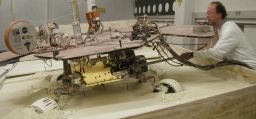 Preparing for pivot test
Preparing for pivot testIn this view from behind a surface system test bed (SSTB) rover at JPL, the rear wheels of the vehicle are turned toward the left, and the left-front wheel is turned toward the the right. Bruce Banerdt, project scientist for Spirit and Opportunity, measures the rover's position before the rover receives commands to drive a forward right arc. The experiment was designed to assess whether this maneuver could pivot the rover around the immobile right-front wheel, since the right-front wheel on Spirit has been inoperable for more than three years. This work on July 15, 2009, was part of a series of tests at JPL designed to determine the best way to get Spirit out of a Martian patch of soft soil called Ulysses in an area known as Troy, where Spirit's wheels have dug in. The test setup, in a box that team members are calling the "dustbin," simulates the situation at Troy. The box holds about 2.7 tons of a powdery mixture of diatomaceous earth and fire clay. This powdery material has physical properties similar to the soil at Troy. The top surface is sloped at 10 degrees.Credit: NASA/JPL-Caltech
Leaving the extrication worries to the humans, Spirit meanwhile continued its ambitious science campaign of remote sensing and in-situ or up-close-and-personal science. It did some more Mössbauer analysis of Cyclops’ Eye, then investigated the target’s mineral composition with it alpha particle X-ray spectrometer (APXS).
On Sol 1963 (July 11, 2009), Spirit re-calibrated its RAT, collected a stack of pictures of Cyclops’ Eye with the MI, then repositioned the RAT on that target to do a seek-scan procedure for locating the surface. The third time always seems to be the charm and this time the instrument made contact.
Two sols later, on Sol 1965 (July 13, 2009), Spirit brushed Cyclops’ Eye, then swung its IDD out of the way. “That brush whisked away basaltic sand and exposed the red substrate,” Arvidson said. Then, on the following sol, the rover collected a series of pictures for an MI mosaic of the brushed Cyclops, and placed the APXS on the target for an overnight integration or observation to determine its composition. “After that, we did a grind-scan, basically put the RAT down while it was rotating and revolving and that actually removed the bright material, exposing a white material,” he said. “So we didn’t have to actually grind into it.”
The subsurface soils that Spirit has been churning up in Ulysses are emplacements of evaporitic minerals, “what we call ‘dirty evaporites,’” Arvidson said, that have likely been brought there and mixed in by processes involving water. And water, remember, is at the heart of NASA’s strategy for exploring Mars.
Throughout July, Spirit continued its nighttime activities, taking images of Venus and everything else it could see in the Martian sky to discharge energy in the two main batteries and maintain their health.
As the third week of July dawned at Gusev Crater Spirit positioned its instruments over Olive Branch, a soil target in Ulysses, and on Sol 1967 (July 15, 2009) collected an MI mosaic before placing the APXS on it. “All of the Olive places are in Ulysses,” Arvidson informed. “Olive Branch actually is a set of six measurements, variably MI, APXS, and Mössbauer at different places along this white material in Ulysses that's coming off the ‘cliff face’ in the rise or slope there. These analyses have been going on all summer at the six different sites on the branch,” he explained. The rover also took pictures for an MI mosaic of Olive Tree, he said, which is the cliff where the stratigraphy or layers are clearly visible.
On Sol 1968 (July 16, 2009), Spirit took more MI pictures for an Olive Branch mosaic, then, placed its Mössbauer spectrometer on the freshly brushed Cyclops’ Eye, re-labeled Cyclops’ Eye 4, for a multi-sol integration over the weekend.
Several sols later, the rover used its RAT to perform another seek-scan procedure on Cyclops’ Eye. With that successful move, Spirit used its RAT, on Sol 1973 (July 21, 2009), ground into the target, which was promptly re-labeled Cyclops’ Eye 5. The rover then placed the APXS on the target for an overnight analysis of its composition.
Amidst collecting data on the soils that have snared it, Spirit continually used its Pancam and Mini-TES to check out selected remote targets, including detailed images of the vertical section of the west side of Home Plate.
At the same time, the Free Spirit crew continued the ‘atomic’ extrication tests, running the ground rover through a forward-right-arc maneuver on July 16, 2009 and looking for even the smallest of movements. In this maneuver, the rover turned its rear wheels toward the left while turning the left-front wheel toward the right, then drove forward to pivot around the broken right-front wheel.
Being this close to even the ground rover has been a bonding experience for some, especially those who haven’t been with the mission since the beginning. “One day we had to reposition the rover and one of the wheels sunk too far in,” recalls Banerdt. “The engineers told me to stick my hand inside and under the wheel to lift it up. It was kind of a thrill. You feel the rocker bogie and the whole rover responding. You really feel this thing. It's a whole different experience.”
The engineers decided to evaluate several repeats of the tight forward-right-arc maneuver and in the ensuing days also commanded the ground rover to perform a clockwise turn in place, a counterclockwise turn in place, crabbing forward with wheels turned to the left, and driving while steering. “We generated a lot of data,” said Laubach. By the end of the third week of July, the first phase, the ‘atomic’ extrication testing, was complete.
 View from Troy
View from TroyThis scene combines seven frames taken by Spirit with its navigation camera during its Sol 1891(April 28, 2009). It covers a vista from south-southeast on the left to northeast on the right. This view is from the position the rover reached with a drive that moved the rover only about 14 centimeters (5.5 inches) earlier on Sol 1891. Spirit's wheels had started to sink into local soil on Sol 1886 (April 23, 2009). After Sol 1891, the rover team attempted five more drives with the rover through Sol 1899 (May 6, 2009), moving the rover only a few centimeters in all, and detecting wheel slippage in excess of 99 percent before deciding to suspend further driving by Spirit until potential maneuvers had been thoroughly evaluated with a test rover on Earth. The site from which Spirit obtained this view has been informally named Troy. Layers of differently hued soil uncovered by the sinking wheels became the subject of intense analysis by the instruments on Spirit's robotic arm. On the horizon at the left edge of this view is a mound capped with light-toned rock and called Von Braun, a possible destination for Spirit to investigate in the future. Between Von Braun and the center of the image is a ridge called "Tsiolkovsky." The hill on the horizon to the right is Husband Hill, where Spirit reached the summit in 2005. Tracks receding toward the north were created as Spirit drove southward toward Troy, driving backward and dragging its right-front wheel, which has been inoperable for more than three years. For scale, the distance between the parallel wheel tracks is about 1 meter (about 40 inches). This view is presented as a cylindrical projection with geometric seam correction.Credit: NASA/JPL/Caltech
Up on Mars, as Spirit was attempting to snap some more MI pictures of Cyclops’ Eye and Olive Branch with its MI on Sol 1975 (July 24, 2009), when Joint 2, the elevation actuator, on its IDD or arm stalled, Laubach reported. “It was near the end of the range of motion of that actuator and the arm was near full extension, and it was something similar to what we'd seen earlier, back in the 1100s I believe,” she said. We weren't too worried about it.” Still, diagnostic test to try and figure out what happened were put on the schedule.
That same sol, down on Earth, the Free Spirit crew was undergoing a review by a panel comprised of JPL engineers and scientists, some formerly of the MER mission. The extrication crew had narrowed their list down to three combinations that they believed should be tested for longer durations. The panel approved their choices. “The scientists also gave their recommendations on how our soil simulant is doing,” Laubach said. “They looked very carefully at the images that we have and the information they've been able to gather from their IDD work and remote sensing work of the soil on Mars and they think there is some differentiation between what's under the right side and left side of the vehicle. Our atomic maneuver testing was using undifferentiated soil. In other words, the soil in the sandbox is all the same cohesiveness and compression on both sides of the rover,” she said.
As a result, the scientists viewed what was in the test rig as “worse” than what Spirit was in on Mars. “If we're seeing progress on Earth, they felt that was very encouraging for what we expect to see on Mars,” Laubach said. “But they did recommend differentiating the soil in the sandbox for the second phase of testing so it would be more like what Spirit is experiencing on Mars.” While they considered changing the mixture, they decided against that. Instead, they just used plywood boards to tamp down or compress the powdery mix of diatomaceous earth and fire clay on the right side of the ground rover.
After the rover snapped some pictures of Olive Pit, a dark pebble in Ulysses, earlier this week, the MER operations team commanded Spirit on Sol 1979 (July 28, 2009), to conduct the diagnostic analysis on the Joint 2 stall in its IDD. That included moving the elbow and turret, moving Joints 3, 4 and 5, to reduce torque on Joint 2, a rotor resistance test of the Joint 2 motor, then a series of small Joint 2 diagnostic motions. The motor resistances all appeared normal and the joint moved successfully to all commanded diagnostic motions, which indicated the stall was a transient event, the joint was okay, and the IDD was working as it should. “We built into the sequence that if the diagnostics worked we'd do an MI and APXS of Olive Branch and those all worked fine,” said Laubach.
On Sol 1980 (July 29, 2009), Spirit turned its attention and its Mössbauer to Polyphemus, a target located about 30 centimeters (about a foot) to the right of Cyclops’ Eye, where it also took a stack of MI pictures and conducted a RAT scan in preparation for grinding into that target. “When we did Cyclops' Eye, we exposed white material, the same white material as is exposed along the cliff face for Ulysses, so Polyphemus is moving off to the right to see if that same layer extends down laterally to the east,” Arvidson explained. The following sol, Spirit ground into Polyphemus, then took pictures of the abraded surface with its MI and followed up with an analysis with the APXS.
Wrapping up July, Spirit turned to take some MI pictures of a target called Sackrider, not too far from Penina, the rover’s first target in Ulysses, which is among the highest sulfate measurements APXS has registered on the mission, according to Arvidson. “Then after that, we'll put the Mössbauer back in Cyclops' Eye, on the white material that's exposed.”
Back in the Mars yard at JPL, the Free Spirit team commanded the ground rover through the three chosen exit strategies. First, the rover drove forward for 100 meters. It made progress, only a few centimeters’ worth, but it was the right direction. The crew then instructed it to crab forward and uphill for almost 90 meters. In the third test, it would back up, crab uphill, then drive forward. “The idea of last two tests is to help rover gain altitude and get away from the obstacle that caused the drive actuator on left middle wheel to stall back in May,” Laubach pointed out.
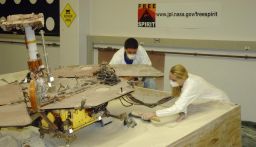 Uphill climb
Uphill climbMER team members continued longer-duration test runs this week, driving the test rover forward and uphill in a crab-like position. JP engineers Matt Van Kirk and Sharon Laubach prepare the "dustbin" for another test. The MER engineers are using a test rover in a big sandbox filled with faux Martian soil made up of diatomaceous earth and powdered fire clay to test a combination of maneuvers that might be used to free Spirit is "mobility imparied" in soft soil dubbed Ulysses in an area called Troy.Credit: NASA / JPL-Caltech
Although the subsequent diagnostics on the left middle wheel failed to recreate the stall, but something obviously caused the stall. “It could be an obstacle outside of the wheel under surface or a ‘potato’ [small rock] that temporarily got scooped up,” said Laubach. By backing up before crabbing up hill, the rover theoretically would not again scoop up that obstacle, whatever it is.
“Through all the tests this week, we saw progress, both uphill and forward progress,” Laubach informed. “It’s very small, on the order of centimeters even though we've commanded 90 to100 meters of driving, but bear in mind that we have what scientists say are worse soil conditions than we have on Mars, as well as Earth gravity, and a heavier vehicle.”
While things are looking good, other unknown factors could still thwart the effort. “For one thing, it isn't clear how far we have to go to get out of this stuff,” Banerdt noted. “At Purgatory, we knew we had just a few meters to go to get Opportunity back onto bedrock. But here, we really don't have any assurance of that and we don't know how deep this material has drifted up against Home Plate.” Consequently, the Free Spirit crew has plenty of reason to be “really cautious” and make sure whatever they command Spirit to do, it doesn’t dig the rover in any deeper.
Both Spirit and its team carry on. “Next week, we'll grind again into Cyclops' Eye to get further down and complete our study here,” said Arvidson. “We're trying to go down, down, down, to see if we can get to another surface, so we'll grind on the top of the old grind. You can see multiple layers in the cliff, which is just 10-15 centimeters (about 4 to 6 inches) to the west of where Cyclops' Eye is located. The interesting point is – unlike any place we have been before where there are sulfate-rich materials exposed at the Spirit site – this time we can actually back out the straigraphic layering and use APXS, Mössbauer, Pancam data, and maybe Mini-TES data if we get the right observations, and the texture from the MI, to tell us what’s happened here,” he explained.
As July turns to August, Spirit continues to produce a prodigious amount of power, with levels hovering now around 915 watt-hours. Its total odometry remains at 7,729.93 meters (4.80 miles).
 View from Troy 3-D
View from Troy 3-DThis stereo scene combines frames taken by Spirit with its navigation camera on its Sol 1891 (April 28, 2009). It covers a vista from south-southeast on the left to northeast on the right. The view appears three-dimensional when viewed through red-blue glasses with the red lens on the left. This view is from the position the rover reached with a drive that moved the rover only about 14 centimeters (5.5 inches) earlier on Sol 1891. Spirit's wheels had started to sink into local soil on Sol 1886 (April 23, 2009). After Sol 1891, the rover team attempted five more drives with Spirit through Sol 1899 (May 6, 2009), moving the rover only a few centimeters in all, and detecting wheel slippage in excess of 99 percent before deciding to suspend further driving by Spirit until potential maneuvers had been thoroughly evaluated with a test rover on Earth. The site from which Spirit obtained this view was dubbed Troy.Credit: NASA/JPL/Caltech
Next Friday morning, August 5, the Free Spirit crew will present their second phase test results to another review panel. “That panel will make sure that we’ve done our due diligence and hopefully will concur on the extraction maneuver that has the best chance of us getting out,” Laubach said. If all goes as hoped, Spirit will begin to extract itself from Ulysses on Friday August 7.
The coming event has drawn crowds to JPL and to the specially created website [http://www.jpl.nasa.gov/freespirit/], and put Spirit back in the spotlight. “The public is really rooting for our girl Spirit and cheering us on and hoping we’ll get her out,” said Laubach. No surprise, really, this rover had the world at first beep.
As big of a science bonanza as Troy is, the scientists are ready to roll. “We're winding down and quite happy to start driving within a week,” Arvidson said. Once Spirit is free, the plan remains the same: continue south to Goddard and von Braun.
Opportunity from Meridiani Planum
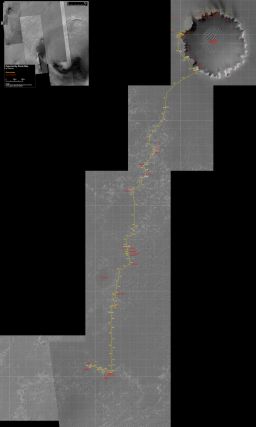 Opportunity route map
Opportunity route mapThis composite of images taken with the HiRISE camera onboard the Mars Reconnaissance Orbiter has been labeled to show Opportunity's route since leaving from Victoria Crater on. The marked route comes courtesy of Eduardo Tesheiner, a member of UnmannedSpaceflight.com.Credit: NASA / JPL-Caltech / UA / Eduardo Tesheiner
Opportunity woke up to July parked at a large expanse of outcrop. It had pulled in there at the end of June to rest its right front wheel and to check out the bedrock and the soils around it, as part of the systematic study of the plains between Victoria Crater and its next major destination Endeavour Crater, still some 15 kilometers away by the route the rover is taking.
As it turns out, the rover’s last sol in June was all but identical to its first sol in July. After taking a stack of pictures of a surface target dubbed Absecon with its microscopic imager (MI) and placing its iron-detecting Mössbauer spectrometer on the target for an overnight integration, Opportunity on Sol 1933 (July 1, 2009), took another stack of MI pictures and again placed the Mössbauer on Absecon, this time for a multi-sol integration. Since the iron-detecting spectrometer has a radioactive power source that is decaying, it takes upwards of 48 hours to get decent enough data. So weekend holidays like this year’s Fourth of July in the U.S. are perfect for these long Mössbauer studies.
On Sol 1938 (July 7, 2009), Opportunity took out its rock abrasion tool (RAT) and conducted a seek-scan procedure on the target in preparation for brushing. Although this first attempt did not succeed, a second RAT seek-scan on the following sol was successful. During the first week of July, Opportunity continued with a new technique to help alleviate the higher-than-normal current being drawn by the right front wheel actuator or motor – heating the right side of its mobility system for a few hours during the day. The rover first tried the technique late last month. It’s an idea that emerged from the “little tiger team,” as Squyres described it, that was given the challenge of devising new techniques to keep that right front wheel properly lubricated.
The thinking is that the combination of warmth and rest might ‘encourage’ the lubricant inside to redistribute throughout the wheel assembly. “We think that when it's warmer, the benefits of resting will accumulate more rapidly,” Squyres explained. Time would tell soon enough.
Opportunity was still parked at the outcrop finishing its science campaign when the second week of the month took hold. But by Sol 1940 (July 9, 2009) though, it had finished its science work and was ready to move on.
The rover drivers commanded Opportunity on Sol 1942 (July 11, 2009) to take a brisk 67-meter (220-foot) jaunt. While the current drawn by the right front wheel motor was slightly elevated, it was much improved to the previous levels. “The daily heating of right side of mobility system seems to have helped spread the lubricant in the wheel assembly and the, combination of resting and heating – cross fingers and knock on wood – seems to have done the trick,” said Laubach.
 Opportunity'view mid-July
Opportunity'view mid-JulyOpportunity used its navigation camera to take the images combined into this 360-degree view of its surroundings during its Sol 1950 (July 19, 2009). South is in the middle; north at both ends. The rover had driven 60.8 meters (199 feet) that sol, moving backward as a strategy to mitigate the increased amount of current drawn by the drive motor in the right-front wheel. The rover was traveling a recently charted westward course to skirt a large field of impassable dunes to the south. Much of the terrain surrounding the Sol 1950 position fetures wind-formed ripples of dark soil, with pale outcrop exposed in troughs between some ripples. A small crater visible nearby to the northwest is Kaiko. For scale, the distance between the parallel wheel tracks is about 1 meter (about 40 inches). This site is about 3.8 kilometers (2.4 miles) south-southwest of Victoria Crater. This view is presented as a cylindrical projection with geometric seam correction.
Credit: NASA / JPL-Caltech
So, on Sol 1946 (July 15, 2009), Opportunity took off on a long drive, making more than 70 meters’ (230 feet) woth of tracks. At the end of the drive, the right front wheel currents had maintained the improvement. The very next sol, the rover drove a little more than 70 meters (230 feet) to the west and only slightly north.
Last month, the MER team changed Opportunity’s route to Endeavour to go around a large field of dunes that were recently deemed too dangerous to deal with. “We're taking a slightly more western route to skirt around purgatoids,” said Laubach.
On Sol 1948 (July 17, 2009) the rover took a break and performed a Marsquake experiment, reading the inertial measurement unit (IMU) accelerometers while parked. There were no Marsquakes to report.
Two sols later, Opportunity made another westward drive, logging almost 61 meters (200 feet) on its odometer and its right front wheel continued to draw just slightly more current than the other wheels. In the images that the rover sent home after this drive, however, the MER scientists spotted a big, dark cobble on the surface some 200 meters (about 650 feet) away to the east and ditched their plan to check out a couple of craters.
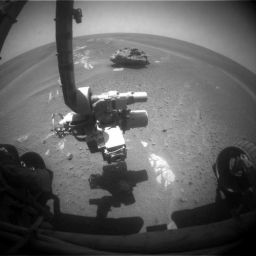 Checking out Block Island
Checking out Block IslandOpportunity is currently checking out a large odd-shaped, dark cobble, about 0.6 meters (2 feet), which may be a meteorite. The team spotted the rock, and dubbed it Block Island on July 18, 2009, located in the opposite direction from which it was driving. The rover then backtracked some 250 meters (820 feet) to study it closer. Scientists will be testing the rock with the alpha particle X-ray spectrometer to determine its composition and to confirm if indeed it is a meteorite.Credit: NASA / JPL-Caltech
“We had driven to a pair of craters, Kaiko and Nereus, then the scientists saw Block Island and the plans changed,” said Laubach.
Opportunity had to backtrack a bit to get to Block Island – a 70-centimeter-size (28-inch) cobble, but it was interesting enough – it sparkled with shiny bits and looked like it might be corroded – that they wanted to look at it up close before checking out Kaiko and Nereus and continuing on toward Endeavour. On Sol 1952 (July 21, 2009), the rover took off to the east with a 23-meter (75-foot) drive toward the Island.
During that drive, Opportunity established yet another rover drive record, passing the 17-kilometer (10.56-mile) mark on its odometer.
Two sols later, Opportunity really put the pedal to the metal, roving for 107.48 meters (352.6 feet) on Sol 1954 (July 23, 2009). Even after that long distance drive, the current to its right front actuator continued to look “close to normal.” So on Sol 1957 (July 26, 2009), the rover put another 87.3 meters (286.4 feet) behind it, and on Sol 1959 (July 28, 2009), drove 24.24 meters (79.5 feet) close to the cobble. It made its final approach to Block Island on Sol 1961 (July 30, 2009).
Throughout the month, Opportunity continued to open the shroud of the remote-sensing Mini-TES instrument for extended periods, most often during the evenings into overnight. It first began doing this last month in hopes the Martian winds would clear the dust from the instrument’s elevation mirror. So far, not a speck seems to have moved. Then again, the rover hasn’t seen any wind events.
As July comes to a close, Opportunity begins its close-up examination of Block Island, as it again rests and warms its right wheels. “Block Island is big enough,” Arvidson said, “and has the characteristics that might tell us something about more recent weathering history than we've been able to retrieve so far.”
 Mid-July view in 3-D
Mid-July view in 3-DOpportunity used its navigation camera to take the images combined into this stereo, 360-degree view of its surroundings on Sol 1950 (July 19, 2009). The view appears three-dimensional when viewed through red-blue glasses (red lens on left). South is in the middle; north at both ends.
Credit: NASA / JPL-Caltech
Support our core enterprises
Your support powers our mission to explore worlds, find life, and defend Earth. You make all the difference when you make a gift. Give today!
Donate

 Explore Worlds
Explore Worlds Find Life
Find Life Defend Earth
Defend Earth


